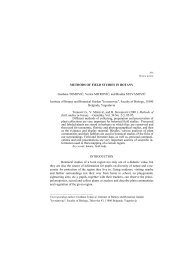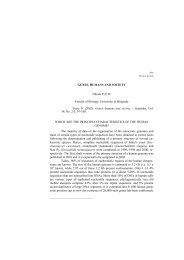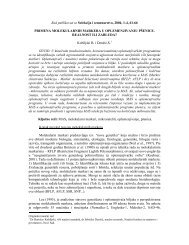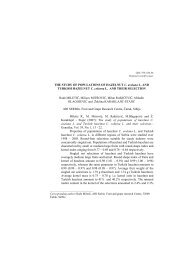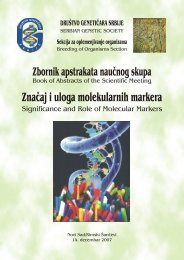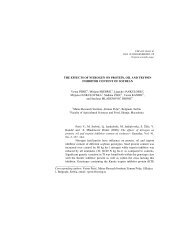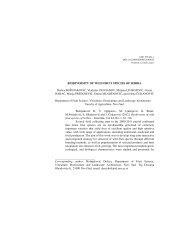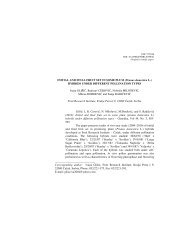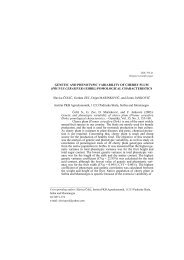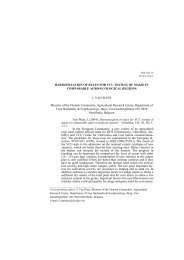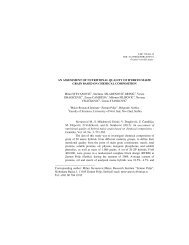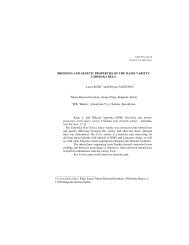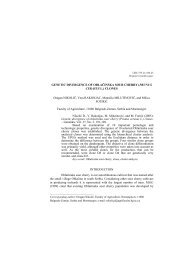Zbornik - Društvo genetičara Srbije
Zbornik - Društvo genetičara Srbije
Zbornik - Društvo genetičara Srbije
Create successful ePaper yourself
Turn your PDF publications into a flip-book with our unique Google optimized e-Paper software.
18 ZBORNIK ABSTRAKATA III KONGRESA GENETIÈARA SRBIJE I-Usm-7<br />
Subotica, 30. novembar - 4. decembar 2004.<br />
GLIADIN CODING GENES OF BREAD WHEAT AS GENETIC<br />
MARKERS OF ADAPTABILITY OF CULTIVAR<br />
Dragovich-Novoselskaya A.Yu.<br />
Institute of General Genetics RAS, Moscow, Russia<br />
Grain storage proteins of bread wheat Triticum aestivum, gliadins, separated by PAAG electrophoresis<br />
are reliable genetic markers used in molecular, genetic and breeding research.<br />
There are six unlinked gliadin-codin loci. A vast multiple allelism has been described at each<br />
of these loci that permit high-precision identification of cultivar genotypes in terms of gliadin<br />
allele composition. As was shown earlier gliadins can be used as genetic markers of bread<br />
making quality, which means that they are linked to genes controlling valuable traits.<br />
In this report we present results of the examined genetic diversity of bread wheat<br />
cultivars, bred in the Saratov plant breeding center during more than last 80 years of the<br />
scientific breeding programs. The aim of our study was to determine the genotypes most<br />
adapted to agro-ecological conditions in the region.<br />
In the early 20 th century Saratov scientific breeding was based on Poltavka, which was<br />
local cultivar-population characterized by rather high intracultivar polymorphism (table.)<br />
In the middle of 20 th century on the basis of Poltavka the best Saratov cultivars (e.g.<br />
Saratovskaya 29) have been developed. About 62% of these cultivars carried biotype<br />
gained from Poltavka (f.e.a.q.s.e.).<br />
Loci/ alleles<br />
Cultivars<br />
Gli-A1 Gli-B1 Gli-D1 Gli-A2 Gli-B2 Gli-D2<br />
Poltavka (1930s) o,f,c, j e, m a q o, s e, a<br />
Poltavka (2003) f E a q s e<br />
Cultivars (1950s). f,i E a q,s s,o, q e<br />
Modern cultivars* f,i,m E a,k q,o, q,w,s, e<br />
*6 new alleles have been found that had not been registered earlier in a catalogue. Bold letters denote<br />
the main Poltavka biotype.<br />
Modern Saratov cultivars, bred in the last decade, are more heterogeneous than the previous<br />
group because of extensively involving alien genetic material. This group comprises 19<br />
alleles, 6 out of them are new, gained from foreign cultivars-donors. Frequencies of these<br />
new alleles have been increasing from year to year. However, the same Poltavka biotype<br />
(f.e.a.q.s.e.) occurs in the group of modern cultivars constituting about 50% of all biotypes<br />
(table). Nowadays, Poltavka which is no more used in breeding, has been grown as collection<br />
pattern from the 1950s till now. This pattern has become a line carrying only one<br />
biotype (f.e.a.q.s.e.), which is more frequent among different Saratov cultivar groups.<br />
Probably, this elimination of other biotypes is caused by natural selection rather than the<br />
absence of artificial selection (e.g. for bread-making). Apparently, high frequency of the<br />
biotype in all the groups can be explained by the fact that definite multilocus combinations<br />
marked by definite gliadin biotypes are selected for particular environment.<br />
The genetic diversity in modern cultivars is twice as high as in the old ones (0.4 and 0.2,<br />
respectively). Intracultivar polymorphism of modern cultivars is 2.2 times higher. Such<br />
high heterogeneity may be attributed to the fact that the large number of genotypes increase<br />
adaptation of cultivars comprising alien (non adaptive) genetic material.



